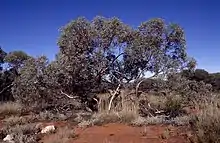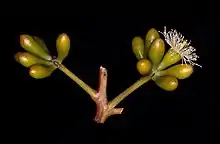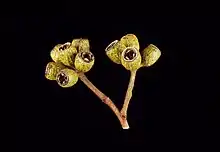| Victoria Spring mallee | |
|---|---|
 | |
| Eucalyptus trivalva in the Great Victoria Desert in Western Australia | |
| Scientific classification | |
| Kingdom: | Plantae |
| Clade: | Tracheophytes |
| Clade: | Angiosperms |
| Clade: | Eudicots |
| Clade: | Rosids |
| Order: | Myrtales |
| Family: | Myrtaceae |
| Genus: | Eucalyptus |
| Species: | E. trivalva |
| Binomial name | |
| Eucalyptus trivalva | |
| Synonyms[1] | |
|
Eucalyptus trivalvis J.W.Green orth. var. | |


Eucalyptus trivalva, commonly known as Victoria Spring mallee[2] or desert mallee,[3] is a species of mallee or small tree that is endemic to arid areas of central Australia. It has rough, partly shed bark on some or all of the trunk, smooth bark above, lance-shaped to elliptical adult leaves, flower buds in groups of nine or eleven, white flowers and cup-shaped, cylindrical or conical fruit.
Description
Eucalyptus trivalva is a mallee or a tree that typically grows to a height of 2 to 8 metres (7 to 26 ft) and forms a lignotuber. It has loose, rough, fibrous, grey to dark grey-brown bark on some or all of the lower stems, smooth coppery to grey or cream-coloured bark above and yellowish branchlets. Young plants and coppice regrowth have leaves that are dull bluish grey to glaucous, egg-shaped, 50–80 mm (2.0–3.1 in) long and 30–55 mm (1.2–2.2 in) wide. Adult leaves are the same shade of dull greyish to bluish green on both sides, lance-shaped to elliptical, 50–140 mm (2.0–5.5 in) long and 8–28 mm (0.31–1.10 in) wide, tapering to a petiole 8–23 mm (0.31–0.91 in) long. The flower buds are arranged in leaf axils on an unbranched peduncle 5–20 mm (0.20–0.79 in) long, the individual buds on pedicels 1–4 mm (0.039–0.157 in) long. Mature buds are oval, to spindle-shaped, 7–10 mm (0.28–0.39 in) long and 4–6 mm (0.16–0.24 in) wide and yellowish green with a conical to rounded operculum. Flowering occurs between January and August and the flowers are white. The fruit is a woody cup-shaped, cylindrical or conical capsule 5–10 mm (0.20–0.39 in) long and 5–8 mm (0.20–0.31 in) wide with the valves at or below rim level.[2][3][4][5][6]
Taxonomy and naming
Eucalyptus trivalva was first formally described by the botanist William Blakely in 1936 in an article published in Transactions and Proceedings of the Royal Society of South Australia.[7][8] The specific epithet (trivalva) is taken from Latin words meaning "three" and meaning "valve", referring to the three-valved fruits produced by this species.[3]
In 1988, George Chippendale changed the name to Eucalyptus trivalvis, (meaning "three-valved", as distinct from "three valve") in Flora of Australia[9] but the change is not accepted by the Australian Plant Census.[1]
Distribution
Victoria Spring mallee is found in arid and semi-arid areas on sand plains, dunes and ridges in central Australia. In Western Australia it is found in central parts of the Goldfields-Esperance, Pilbara, and Mid West regions from around Newman in the north to Kalgoorlie in the south. In the Northern Territory it is found south from near Alice Springs and in South Australia in western parts in open mallee vegetation on gravelly sands and on rocky rises.[2][3][6]
See also
References
- 1 2 3 "Eucalyptus trivalva". Australian Plant Census. Retrieved 12 January 2020.
- 1 2 3 "Eucalyptus trivalva". FloraBase. Western Australian Government Department of Biodiversity, Conservation and Attractions.
- 1 2 3 4 "Eucalyptus trivalva (Myrtaceae) Desert Mallee". Seeds of South Australia. Government of South Australia. Retrieved 16 November 2017.
- ↑ "Eucalyptus trivalva". Euclid: Centre for Australian National Biodiversity Research. Retrieved 28 May 2020.
- ↑ Chippendale, George M. "Eucalyptus trivalvis". Australian Biological Resources Study, Department of the Environment and Energy, Canberra. Retrieved 12 January 2020.
- 1 2 "Eucalyptus trivalvis". Northern Territory Government. Retrieved 12 January 2020.
- ↑ "Eucalyptus trivalva". APNI. Retrieved 12 January 2020.
- ↑ Blakely, William. "Descriptions of three new species and one variety of Eucalyptus of the Elder and Horn expeditions, the "white-wash gum" of central Australia, and the re-discovery of Eucalyptus orbifolia F. v. M." Transactions and proceedings of the Royal Society of South Australia. p. 155. Retrieved 12 January 2020.
- ↑ "Eucalyptus trivalvis". APNI. Retrieved 12 January 2020.